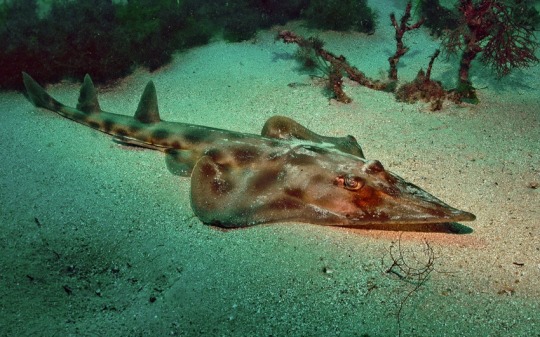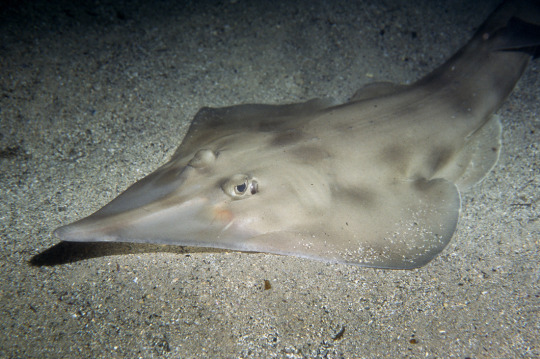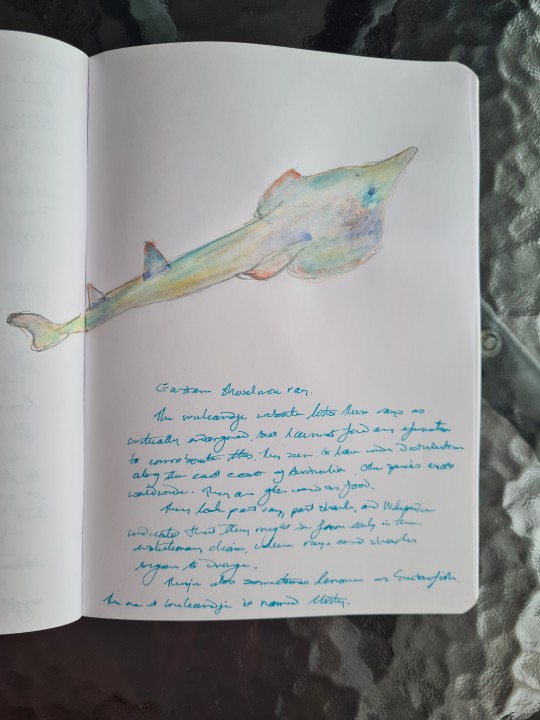#eastern shovelnose ray
Text
Daily Ray Fact:
The Eastern Shovelnose Ray is a species of guitarfish and recent studies suggest this species may have trichromatic colour vision due to the discovery of three spectrally distinct cone visual pigments in the retinae. The eastern shovelnose ray also expresses a difference in tooth and jaw structure according to sex, with males developing a more pronounced lower jaw, longer and sharper teeth, and greater jaw strength to enable males to grip a female's fin during mating.


#eastern shovelnose ray#shovelnose#guitarfish#respect the locals#cartilaginous fish#fish facts#ray facts#daily ray facts#daily stingray facts#daily stingray#ray family#ray#ocean#ocean life#marine#marine life#marine biology#ray post
97 notes
·
View notes
Text
day 27, 19/02/24 - fish of the day is the eastern shovelnose ray (Aptychotrema rostrata)

6 notes
·
View notes
Text

An Eastern shovelnose ray in Nelson Bay, New South Wales, Australia.
The Eastern shovelnose ray (Aptychotrema rostrata) is a species of guitarfish, small to medium-sized, with a wedge-shaped disc and a long, flattened triangular snout. This species is endemic to eastern Australia and resides in subtropical and temperate waters from southern Queensland to southern New South Wales. They inhabit sandflats and seagrass beds in bays around rocky reefs and in surf zones, at depths of about 100 m.
Eastern shovelnose rays can reach a maximum total length of 120 cm (47 in) and there are two dorsal fins of roughly equal size on top of its long shark-like tail. Generally sandy or greyish-brown on its dorsum, it has darker blotches on its body, a blackish tip on the snout and its underside is pale with dark flecks. It feeds on fishes and a variety of benthic invertebrates, including prawns, shrimps, crabs, stomatopods, and molluscs.
📷 Andy Murch (bigfishexpeditions)
www.instagram.com/bigfishexpeditions/?hl=en
9 notes
·
View notes
Text

Eastern shovelnose ray - a cross between a ray and a shark.
1 note
·
View note
Text
Shore diving Bundaberg: from nudibranchs to dugongs
Mention Bundaberg to most Aussie divers and they will think of Lady Elliot Island or rum, or possibly both! However, for divers in the know they will automatically think about the wonderful and easy shore diving to be found off this sugar town.
Bundaberg, located four hours drive north of Brisbane, is a busy country town known as the sugar capital of Australia. Surrounded by sugar cane fields that go into producing the town’s most famous export – rum, the town is also the gateway to the Southern Great Barrier Reef, with day trips to Lady Musgrave Island and Lady Elliot Island only a short flight away. However, Bundaberg also has some of its own local dive sites that are well worth a look. Located off the coast are brilliant boat dives on coral reefs, the recently scuttled HMAS Tobruk, the incredible MV Karma shipwreck and the always fascinating Cochrane Artificial Reef. But the town also has Queensland’s best shore diving sites.
Known as the Coral Coast, the coastline off Bundaberg is mostly rocky, formed over a million years ago by volcanic eruptions. These rocks continue underwater and have allowed corals to establish and flourish in shallow water. While you can jump in the water just about anywhere on this coast, the three most popular dive sites are Barolin Rocks, Hoffman’s Rocks and Burkitt’s Reef.
Getting in and out of the water at Barolin Rocks is always a bit of a challenge as you have to scramble over slippery rocks, but there is a large rock pool that makes this a little easier. Once in the water you will find yourself in an incredible coral garden, with the rocks covered in hard and soft corals in depths from 1m to 5m. This beautiful coral garden is so unexpected that it always takes new divers by surprise. Beyond the coral gardens are small bommies and patches of coral in depths to 9m. Always have a close look at these corals, especially the gorgonians, as many are home to lovely spindle cowries.
While there are certainly larger creatures at Barolin Rocks, it is the macro critters that are its main feature, especially nudibranchs. Over a dozen species of these colourful sea slugs can be seen, including Spanish dancers. Other critters seen at this site include crabs, flatworms, sea hares, head shield slugs, crayfish and tubeworms. Numerous small reef fish dart amongst the corals, including butterflyfish, boxfish, wrasse, angelfish, gobies and blennies. But larger residents include blue spotted stingrays, rock cods, ornate wobbegongs and the occasional eastern shovelnose ray. Also keep an eye out for green and hawksbill turtles sleeping on the coral or olive sea snakes searching the bottom for prey.
Barolin Rocks most famous resident is a dugong. This wonderful sea cow is only seen at the site a handful of times a year, so an encounter is never guaranteed. I have been fortunate to have three encounters with this dugong, and each time it has swum around me several times as if closely studying the strange bubble-blowing alien visitor to its home. Having a semi-resident dugong makes this one of the most unique dive sites in Australia.
Hoffman’s Rocks requires another scramble over the rocks to get in and out, but it is well worth the effort. This site is a maze of bommies and coral ridges, covered in soft and hard corals, gorgonians and sponges in depths to 10m. This site also has a good collection of nudibranchs and reef fishes, but more exposed to the elements, and sometimes washed by a gentle current, Hoffman’s Rocks is where you will see larger species and pelagic visitors. Often seen here are turtles, sea snakes, Queensland gropers, Spanish mackerel, golden trevally, batfish, snapper, sweetlips and even spotted eagle rays.
For those that don’t like slippery rocks, Burkitt’s Reef is accessible from the beach. Located right in front of Bargara township, this large reef can be dived from the southern end of Bargara Beach or the northern end of Kelly’s Beach. This site also has pretty coral gardens and small bommies to explore in depths to 9m. Like the other sites it is a great spot for nudibranchs. Also seen at Burkitt’s Reef are crayfish, moray eels, sea snakes, tasselled wobbegongs and schools of pelagic fish.
Bundaberg’s Coral Coast can be dived year-round, with the visibility averaging around 6m to 10m on a good day, but varying from zero to 15m. It is best dived when the winds are light and there is little or no swell, as heavy seas stir up the visibility and make entries and exits more difficult. Also avoid the area if there has been recent heavy rain, as with two rivers and a creek draining into this area the water can turn brown. Winter is often the best time to dive this area, as there is little rain at this time of year.
The post Shore diving Bundaberg: from nudibranchs to dugongs appeared first on Diveplanit.
from Diveplanit https://ift.tt/3gnVRSB
0 notes
Text
Scuba Diving Cook Island, Australia
Queensland’s Gold Coast is Australia’s version of Disney World with theme parks galore. But just off shore at the southern end of the “Goldie” as locals call it, lies Cook Island, home to a wide array of marine life including nudibranchs, stingrays, turtles, wobbegong sharks and even leopard sharks during the summer. If you’re visiting the Gold Coast, scuba diving Cook Island is not to be missed.
Diving Cook Island
While it’s mainly known for theme parks and surfing, there are many wonderful dive sites off Australia’s Gold Coast, a stretch of coastline that runs from southern Queensland to northern New South Wales. Cook Island is easily one of the best all-weather sites.
Named after the famous English explorer James Cook, the island was once called Turtle Island because its rocky reefs are home to a large population of sea turtles. Located about ½-mile (600 m) off Fingal Head, Cook Island is easily accessible by boat from the Tweed River. All around the island are rocky reefs in depths from 15 to 60 feet (5 to 18 m). There are a variety of sites; Northern Ledges is one of the best to see turtles.
Northern Ledges
This site, on the normally sheltered northern side of the island, features a rocky wall that drops from 15 feet to 36 feet (5 to 11 m). On the top of the wall are coral gardens, anemones full of anemonefish, abundant small reef fish and plenty of green turtles. Turtles gather here for a cleaning, and it’s common to see a dozen or more lingering in the shallows. These turtles are quite used to divers and will allow you to get very close for photos. Still, remember to respect their space.
Most divers spend their time on the rocky wall observing moray eels, wobbegongs, crayfish, bullseyes, gropers, leopard blennies, blind sharks, boxer shrimp, pipefish, lionfish and even pineapplefish. It’s also a great spot for macro photography with loads of small critters and a good variety of colorful nudibranchs, including exotic Spanish dancers.
While many divers stick to the wall, the sand flats beyond are also home to large and small marine life. You may see spotted and ornate wobbegongs, sleeping turtles, blue-spotted stingrays, round ribbontail rays and large white-spotted shovelnose rays. In summer, numerous leopard sharks gather here and you can see them resting on the bottom. A closer look will also reveal flatworms, nudibranchs, scorpionfish, velvetfish, cowry shells, ghost pipefish, mantis shrimp and the occasional seahorse.
Mary’s Rock
Off the very northern end of Cook Island is Mary’s Rock, a pinnacle surrounded by gutters, walls and caves in depths to 60 feet (18 m). Pelagic fish, wobbegongs, turtles, eagle rays, gropers and even gray nurse sharks inhabit the area. The rocky reefs are also covered in lovely hard and soft corals, pretty sponges, black coral trees, gorgonians, ascidians and sea ferns.
Other sites
You can only dive the eastern side of Cook Island when the seas are calm. In this area you’ll find numerous ledges and caves in depths from 20 to 40 feet (6 to 12 m). Take a torch to explore these caves as it will help to spotlight the resident banded wobbegongs, loggerhead turtles, brown-banded bamboo sharks, crayfish, soapfish, squirrelfish, slipper lobsters, lionfish, gropers and pineapplefish.
The southern side of Cook Island features another boulder wall dropping to 50 feet (15 m). You’ll find lovely hard and soft corals and common reef fish such as morwong, wrasse, angelfish, butterflyfish, grubfish, hawkfish, pufferfish, gobies, blennies and leatherjacks. This is also a good spot to see green and hawksbill turtles, wobbegongs and pelagic fish. Manta rays visit a small bommie in the area during the summer over the summer months to get cleaned.
One of the best sites off the western side of Cook Island is a site called Turtle Bommie. This rocky reef is always a great dive, with wobbegongs, turtles, stingrays, stingarees, crayfish and abundant reef fish.
Diving Cook Island is possible any time of the year, with visibility typically 20 to 40 feet (6 to 12 m) and generally clearest after a spell of southerly winds. The island is a marine reserve and a number of dive operators visit Cook Island each weekend. Being an all-weather site there is always somewhere to dive.
Deborah Dickson-Smith is one half of Diveplanit, a dive travel website she manages with her partner Simon Mallender, based in Australia. Underwater photographer Nigel Marsh also contributed to this story.
The post Scuba Diving Cook Island, Australia appeared first on Scuba Diver Life.
from Scuba Diver Life https://ift.tt/2IgPS4c
0 notes
Text
Scuba Diving Cook Island, Australia
Queensland’s Gold Coast is Australia’s version of Disney World with theme parks galore. But just off shore at the southern end of the “Goldie” as locals call it, lies Cook Island, home to a wide array of marine life including nudibranchs, stingrays, turtles, wobbegong sharks and even leopard sharks during the summer. If you’re visiting the Gold Coast, scuba diving Cook Island is not to be missed.
Diving Cook Island
While it’s mainly known for theme parks and surfing, there are many wonderful dive sites off Australia’s Gold Coast, a stretch of coastline that runs from southern Queensland to northern New South Wales. Cook Island is easily one of the best all-weather sites.
Named after the famous English explorer James Cook, the island was once called Turtle Island because its rocky reefs are home to a large population of sea turtles. Located about ½-mile (600 m) off Fingal Head, Cook Island is easily accessible by boat from the Tweed River. All around the island are rocky reefs in depths from 15 to 60 feet (5 to 18 m). There are a variety of sites; Northern Ledges is one of the best to see turtles.
Northern Ledges
This site, on the normally sheltered northern side of the island, features a rocky wall that drops from 15 feet to 36 feet (5 to 11 m). On the top of the wall are coral gardens, anemones full of anemonefish, abundant small reef fish and plenty of green turtles. Turtles gather here for a cleaning, and it’s common to see a dozen or more lingering in the shallows. These turtles are quite used to divers and will allow you to get very close for photos. Still, remember to respect their space.
Most divers spend their time on the rocky wall observing moray eels, wobbegongs, crayfish, bullseyes, gropers, leopard blennies, blind sharks, boxer shrimp, pipefish, lionfish and even pineapplefish. It’s also a great spot for macro photography with loads of small critters and a good variety of colorful nudibranchs, including exotic Spanish dancers.
While many divers stick to the wall, the sand flats beyond are also home to large and small marine life. You may see spotted and ornate wobbegongs, sleeping turtles, blue-spotted stingrays, round ribbontail rays and large white-spotted shovelnose rays. In summer, numerous leopard sharks gather here and you can see them resting on the bottom. A closer look will also reveal flatworms, nudibranchs, scorpionfish, velvetfish, cowry shells, ghost pipefish, mantis shrimp and the occasional seahorse.
Mary’s Rock
Off the very northern end of Cook Island is Mary’s Rock, a pinnacle surrounded by gutters, walls and caves in depths to 60 feet (18 m). Pelagic fish, wobbegongs, turtles, eagle rays, gropers and even gray nurse sharks inhabit the area. The rocky reefs are also covered in lovely hard and soft corals, pretty sponges, black coral trees, gorgonians, ascidians and sea ferns.
Other sites
You can only dive the eastern side of Cook Island when the seas are calm. In this area you’ll find numerous ledges and caves in depths from 20 to 40 feet (6 to 12 m). Take a torch to explore these caves as it will help to spotlight the resident banded wobbegongs, loggerhead turtles, brown-banded bamboo sharks, crayfish, soapfish, squirrelfish, slipper lobsters, lionfish, gropers and pineapplefish.
The southern side of Cook Island features another boulder wall dropping to 50 feet (15 m). You’ll find lovely hard and soft corals and common reef fish such as morwong, wrasse, angelfish, butterflyfish, grubfish, hawkfish, pufferfish, gobies, blennies and leatherjacks. This is also a good spot to see green and hawksbill turtles, wobbegongs and pelagic fish. Manta rays visit a small bommie in the area during the summer over the summer months to get cleaned.
One of the best sites off the western side of Cook Island is a site called Turtle Bommie. This rocky reef is always a great dive, with wobbegongs, turtles, stingrays, stingarees, crayfish and abundant reef fish.
Diving Cook Island is possible any time of the year, with visibility typically 20 to 40 feet (6 to 12 m) and generally clearest after a spell of southerly winds. The island is a marine reserve and a number of dive operators visit Cook Island each weekend. Being an all-weather site there is always somewhere to dive.
Deborah Dickson-Smith is one half of Diveplanit, a dive travel website she manages with her partner Simon Mallender, based in Australia. Underwater photographer Nigel Marsh also contributed to this story.
The post Scuba Diving Cook Island, Australia appeared first on Scuba Diver Life.
from Scuba Diver Life https://ift.tt/2IgPS4c
0 notes